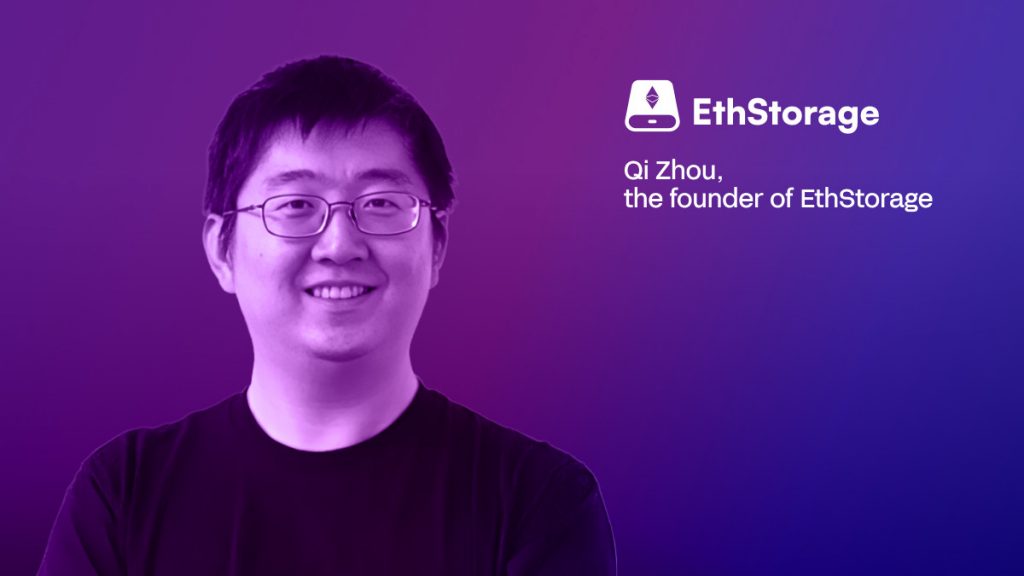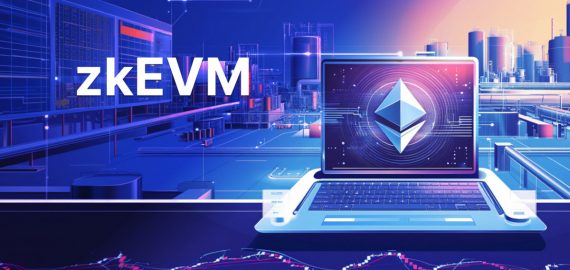Programmable, Dynamic, and Scalable: Inside EthStorage’s Vision for the Future of Blockchain Data with Founder Qi Zhou


In Brief
Qi Zhou, founder of EthStorage, discusses Ethereum’s storage capabilities and the potential of decentralized storage, highlighting challenges, opportunities, and future prospects in the Web3 space.

In this interview, we sit down with Qi Zhou, the founder of EthStorage. With a background in software engineering at tech giants like Facebook and Google, Zhou brings a wealth of experience to the Web3 space. His innovative approach to scaling Ethereum’s storage capabilities through a Layer 2 solution promises to transform blockchain infrastructure. Zhou shares insights on the challenges, opportunities, and future of decentralized storage in this engaging conversation.
Can you share your journey to Web3?
Before joining Web3, I was a software engineer at companies like Facebook and Google, working on infrastructure systems. In 2017-2018, I started noticing a lot of new projects emerging in the Web3 space, and I realized there were many missing pieces in terms of infrastructure. I believe I could leverage my previous expertise to help build better infrastructure for Web3. That’s why I decided to make the transition from Web2 to Web3 full-time.
Did Google and other Web2 companies use blockchain for their solutions at that time?
No, not at that time. In 2018, I actually wrote an email to Zuckerberg suggesting that Facebook should have a strategic plan in this area. Everything was still very new for the Web2 companies. Later, after I left Facebook, they set up the Libra project, which has now become Diem and Sui. I felt it was a great opportunity for me to contribute my expertise from the Web3 world to the Web2 world.
Could you please provide more details on the storage solutions your company offers?
The basic idea is that we can store data off-chain while using smart contracts on the Ethereum mainnet to prove that the off-chain data is being persistently stored. This is similar to the approach used for existing Layer 2 scaling solutions but focused on scaling storage instead of computation.
We believe that for Ethereum to truly scale, it needs to scale in both computation and storage. While the primary focus has been on improving transactions per second, the ability to store and access large amounts of data on the Ethereum network will be a key feature in the future.
How does a programmable dynamic key-value store based on Ethereum’s data availability differ from traditional blockchain storage solutions?
Traditional blockchain storage solutions like Filecoin and Arweave are more designed for static files, where the data cannot be easily deleted, replaced, or modified. Additionally, the proof of storage unit size for these solutions is typically very large, in the range of gigabytes.
Our design is more focused on “hot data” that needs to be dynamic. We allow small pieces of data, in the range of kilobytes, to be associated with a key and then replaced or deleted based on smart contract logic. This makes it a programmable key-value store, which enables a wide range of new applications.
Most Web2 applications, such as Twitter, Google Docs, and YouTube, are built on top of internal key-value databases. Our goal is to provide a similar decentralized infrastructure built on top of Ethereum so that new Web3 applications like NFT projects or personal blogs can be hosted on the Ethereum network using our storage scaling solution.
How is data stored and retrieved in a programmable dynamic key-value store implemented on the Ethereum blockchain?
The key idea is that our storage solution becomes a superset of the Ethereum data. The Ethereum mainnet maintains the state, and our storage solution has metadata called “data hashes” that are stored on the Ethereum smart contract. The actual data corresponding to these hashes is stored off-chain, but there is an incentive mechanism using Ether that rewards the data nodes for their contribution to storage over time.
This token economy is crucial to ensure the sustainability of the system, as we have learned from the failures of many Web2 projects. We encourage developers to explore the details of our smart contracts and build applications on top of our storage solution.
Can you elaborate on the limitations of using the Ethereum Virtual Machine for data storage?
The Ethereum Virtual Machine has basic data storage capabilities, such as the `SSTORE` opcode and contract code storage. However, the main limitation is that every node in the Ethereum network has to maintain a replica of the state. This means that the data is highly redundant, with around 4,000 nodes each having a copy of the data.
Replicating large amounts of data to 4,000 nodes would be extremely expensive. Additionally, to minimize the cost of operating an Ethereum node, the storage capacity of each node is limited to a few terabytes. This makes it impractical to store multi-terabyte datasets on the Ethereum mainnet.
While the Ethereum mainnet provides high availability due to the redundancy, the cost and limited capacity are significant drawbacks. This is why we believe that a Layer 2 approach to storage is necessary to solve these problems.
What are the advantages and disadvantages of using Layer 2 solutions like roll-ups or data storage on Ethereum?
The main advantage of using a Layer 2 storage solution like our approach is that we can scale Ethereum storage by around 1,000 times, both in terms of capacity and cost. By storing data hashes on-chain and the actual data off-chain, we can significantly expand the storage capabilities of the Ethereum network.
However, there are a few challenges as well. One is that it’s difficult to upgrade the Ethereum protocol to support new features or algorithms required by the storage solution. We need to work around this using advanced technologies like ZK-SNARKs.
Another challenge is the high gas costs on Ethereum, which can fluctuate dramatically. This creates issues for a storage solution that expects more predictable gas prices. Fortunately, we believe Ethereum is gradually addressing these problems as part of its roadmap.
What are the main challenges in designing a storage solution that maintains Ethereum’s security properties while significantly expanding capacity?
One of the primary challenges is working around the high gas costs on Ethereum. To support off-chain storage algorithms, like proof-of-storage, the verification costs on-chain need to be very low. We’ve addressed this by implementing ZK-SNARK algorithms, which significantly reduce the verification costs.
Another challenge is the gas costs for general computation and storage on Ethereum. To address this, we’re exploring implementing our storage solution as a Layer 3 on top of Ethereum so that users can benefit from the low gas costs for both computation and storage.
Our goal is to enable Ethereum to serve both computation-heavy tasks like DeFi, as well as storage-heavy tasks like social media, file storage, and NFTs. By solving the scalability problem for both computation and storage, we believe Ethereum can become a truly versatile platform for a wide range of Web3 applications.
Can you explain how your storage solution addresses the blockchain dilemma of decentralization, security, and scalability?
Our storage solution primarily addresses the scalability aspect of the blockchain trilemma. We’re able to achieve significant scaling of data storage by using smart contract-based data sharding, which was the original goal of Ethereum 2.0.
At the same time, we’re able to borrow the security properties of the Ethereum mainnet, ensuring decentralization and security. We’re building on the work done by existing Ethereum Layer 2 solutions, inheriting their advancements in scaling computation.
So, in essence, we’re complementing the scalability of computation with the scalability of storage, all while maintaining the security and decentralization guarantees of the Ethereum ecosystem.
Are there any other advancements in the blockchain industry, not just Ethereum, that seem promising for the storage solution sector?
Yes, there are some interesting developments in the broader blockchain industry. Projects like Filecoin and Arweave have constantly evolved their storage solutions. For example, Filecoin has introduced its Filecoin Virtual Machine (FVM), which allows running EVM on top of their network.
Arweave has a solid storage solution that is being used by many NFT projects to store data. They are also exploring new features like Arweave Computation (AC), which aims to provide a computation network alongside their storage capabilities.
We see a trend of projects trying to combine storage and computation scaling solutions into a single blockchain. This is an interesting direction, and we believe there is still room for innovation, especially in the area of programmable, dynamic key-value storage on top of Ethereum.
Do you think AI can be used to enhance blockchain storage solutions?
Absolutely. There are several ways AI can be leveraged to enhance blockchain storage solutions. For example, AI can be used to automate the process of collecting high-quality training data and labeling it, which is a significant challenge in the AI field. By leveraging decentralized storage solutions, this data can be made visible and accessible to everyone, enabling the democratization of AI training.
Another area where AI can be beneficial is in the context of AI inference. If an AI model is used to generate content, such as an image, the storage solution can provide a way to prove the authenticity and provenance of that content, allowing everyone to access and verify the data.
There are many interesting ideas at the intersection of AI and blockchain storage, and we welcome developers and ecosystem partners to collaborate with us to explore these possibilities further.
What are the best practices that developers can follow to optimize storage usage and costs on the Ethereum blockchain?
We encourage developers to explore the resources on our website, which provide an introduction to our storage protocol. We also have ongoing events and campaigns on our testnet, where developers can deploy applications and experience how our storage solution works.
Additionally, developers are welcome to join our Discord and Telegram and engage directly with our engineers. They can also file issues on our GitHub repository to contribute to the development of our storage solution.
We are committed to building a better Web3 ecosystem, and we welcome developers to collaborate with us and leverage our storage solution to optimize their applications.
How do you foresee the development of the blockchain industry in the next three years?
I believe the blockchain industry will see a shift towards more automated and decentralized management processes. Currently, many blockchain projects are still managed in a centralized way, with foundations and treasuries controlling the development.
In the future, I expect to see more on-chain development, where the code, infrastructure, and even discussion channels can be hosted and managed entirely on the blockchain, reducing the dependency on centralized platforms like GitHub.
This transition towards self-contained, decentralized development will be an important indicator of the industry’s maturity. Just as the ability to self-compile a programming language’s compiler is a sign of language maturity, the blockchain industry’s ability to host its own development infrastructure on-chain will showcase its true decentralization.
I’m excited about the potential of Web3 to bring more value to users by minimizing the dependency on centralized entities. This is the direction I believe the blockchain industry will be heading in the next three years and beyond.
Disclaimer
In line with the Trust Project guidelines, please note that the information provided on this page is not intended to be and should not be interpreted as legal, tax, investment, financial, or any other form of advice. It is important to only invest what you can afford to lose and to seek independent financial advice if you have any doubts. For further information, we suggest referring to the terms and conditions as well as the help and support pages provided by the issuer or advertiser. MetaversePost is committed to accurate, unbiased reporting, but market conditions are subject to change without notice.
About The Author
Victoria is a writer on a variety of technology topics including Web3.0, AI and cryptocurrencies. Her extensive experience allows her to write insightful articles for the wider audience.
More articles

Victoria is a writer on a variety of technology topics including Web3.0, AI and cryptocurrencies. Her extensive experience allows her to write insightful articles for the wider audience.

















































